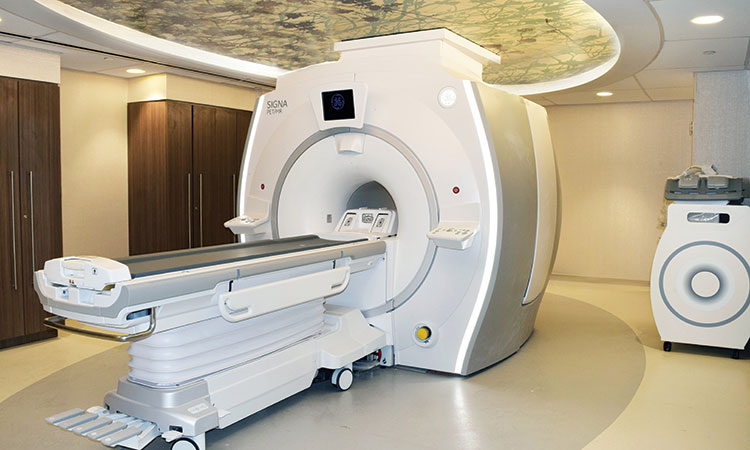By Kate Steinmetz
White Plains Hospital becomes one of 115 health facilities in the world (and the first in New York State, outside of Manhattan) to offer the advanced hybrid imaging technology.

Medicine continues to evolve and adapt, as does imaging technology. White Plains Hospital stays at the forefront of acquiring cutting-edge imaging technology to help with early detection, monitoring and staging disease, and now offers PET/MRI to patients.

“Over the 31 years I’ve been here, I’ve observed the hospital’s commitment to adopting the earliest diagnostic technology to improve our patient care,” says Andre Khoury, MD, Co-Director of Radiology at White Plains Hospital. “It started with the 1.5T magnet three decades ago, which was state of the art for the time. Then we obtained PET before the PET/CT scan. This year, we are excited to offer this impressive PET/MRI technology in our new Center for Advanced Medicine & Surgery. We have three fully proficient neuroradiologists on our team to read cases.”
“Treatment is evolving, which means we have to stay up-to-date with the latest in diagnostic technology. This new PET/MRI scanner allows us to provide exceptional care for everyone from children with cancer to adults with prostate cancer, without the potentially harmful impact of excess radiation. We are proud to offer this technology close to home for your patients’ convenience.”
— Andre Khoury, MD, Co-Director of Radiology at White Plains Hospital
Accurate Imaging With Less Radiation
A PET/MRI scan combines the high resolution and exceptional imaging quality of MRI with physiological information collected from PET. When compared with PET/CT, PET/MRI has better motion correction, the added component of diffusion weighted imaging, and improved soft tissue contrast, to name a few advantages. Importantly, patients who have PET/MRI are exposed to reduced amounts of potentially harmful ionizing radiation.
“While studies are still coming that prove the technology’s success, we’ve already seen about 60% to 80% less radiation exposure using PET/MRI,” Dr. Khoury says. “This is key for our pediatric oncology patients. Another initial study shows a 30% better detection rate for small cancers. Anything that lowers radiation and increases our detection is an immediate gain.”
The Future of PET/MRI
Current research indicates promising avenues for translating the advantages of PET/MRI and its expanding capabilities into improved diagnostic and therapeutic applications. Here are exciting advances to look out for in the future:
Breast cancer imaging: Current evidence does not support the use of PET in breast cancer imaging. However, advances in PET radiomics may widen the spectrum of features, especially when combined with MRI. PET may be a trend to watch for in the clinical management of breast cancer.
Cardiac applications: PET/MRI is a promising approach to detect and characterize ischemic and non-ischemic cardiomyopathies.
Improvements to Alzheimer’s disease detection: In the future, the use of PET/MRI may further improve the diagnosis of Alzheimer’s disease with the use of amyloid- and tau tangle-specific tracers.
Infectious and inflammatory diseases: Until recently, SPECT and planar imaging were primary techniques to acquire imaging of infection or inflammation. The addition of more PET radiopharmaceuticals allows for more nuanced detection and quantification of certain aspects of inflammatory processes. This means that the application of hybrid whole-body PET/MRI can help investigate infectious and inflammatory diseases, including Crohn’s disease and ulcerative colitis.
Clinical Applications
The benefits of PET/MRI are apparent for multiple applications. These include:
Pediatric Cancer
Children who have cancer may require multiple treatments through the years. PET/MRI helps stage and assess tumor response and recurrence of pediatric extracranial solid tumors while limiting radiation exposure. Children who have PET/MRI benefit from the robust information provided by synchronized, simultaneously obtained imaging, along with less radiation, reduced hospital visits and decreased amounts of sedation/anesthesia. MRI has become the standard of care for evaluating solid tumors due to concern about ionizing radiation, which means PET/MRI may replace PET/CT as the primary imaging modality for pediatric patients.
Adult Cancers
PET/MRI is comparable if not superior to PET/CT in cancer imaging, especially for cancers in the head and neck, pelvis, and prostate. In a study published in the Journal of Nuclear Medicine, researchers discovered that PET/MRI improves lesion detectability and helps promote quick, efficient local and whole-body staging. The additional metabolic information provided by PET improves the accuracy of magnetic resonance in head and neck tumors. For patients with prostate cancer, PET/MRI helps detect recurrent tumors for patients with increased PSA post-treatment.
“The FDA approved Gallium 68 PSMA-11, which is an important tool that helps us assess prostate cancer,” Dr. Khoury says. “We can detect cancer and see whether or not it has spread, with less radiation exposure. For prostate cancer, PET/MRI is the best test we have to this point.”
Neurological Disorders
PET/MRI can be used to differentiate Alzheimer’s disease from other neurological disorders, which is more important than ever with the introduction of the first FDA-approved therapy to potentially treat the underlying causes of Alzheimer’s disease. One study showed PET/MRI had a 94% accuracy rate when used to differentiate Alzheimer’s disease from frontotemporal lobar degeneration. PET/MRI also is being expanded and applied in cases of epilepsy, stroke, traumatic brain injury and movement disorders. For certain seizures, PET/MRI is a better choice than MRI or CT alone to detect abnormal areas and guide surgical treatment.
“Besides Alzheimer’s, we have the technology and ability now to enter into other research programs,” Dr. Khoury says.
To learn more about the PET/MRI and diagnostic imaging at White Plains Hospital, visit wphospital.org/petmri.
Source: MD News August/September 2021, Lower Hudson/Bronx Edition
